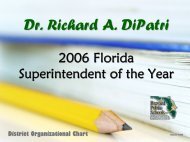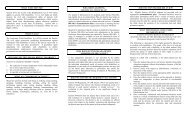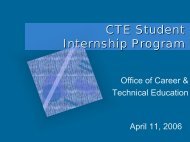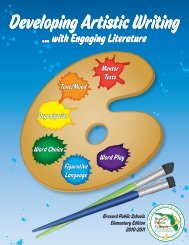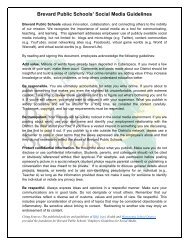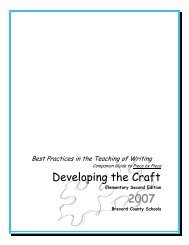by Piece - Brevard Public Schools
by Piece - Brevard Public Schools
by Piece - Brevard Public Schools
Create successful ePaper yourself
Turn your PDF publications into a flip-book with our unique Google optimized e-Paper software.
Sixth Grade<br />
Sunshine State Standards p. 50<br />
WRITING PROCESS<br />
Prewriting Standard: The student will use prewriting strategies to generate ideas and formulate a plan.<br />
The student will prewrite <strong>by</strong>:<br />
LA.6.3.1.1 - generating ideas from multiple sources (e.g., prior knowledge, discussion with others, writer’s<br />
notebook, research materials, or other reliable sources), based upon teacher-directed topics and personal<br />
interests;<br />
LA.6.3.1.2 - making a plan for writing that prioritizes ideas, addresses purpose, audience, main idea, and<br />
logical sequence; and<br />
LA.6.3.1.3 - using organizational strategies and tools (e.g., technology, outline, chart, table, graph, web,<br />
story map).<br />
Drafting Standard: The student will write a draft appropriate to the topic, audience, and purpose.<br />
The student will draft writing <strong>by</strong>:<br />
LA.6.3.2.1 - developing main ideas from the prewriting plan using primary and secondary sources<br />
appropriate to purpose and audience;<br />
LA.6.3.2.2 - organizing information into a logical sequence and combining or deleting sentences to enhance<br />
clarity; and<br />
LA.6.3.2.3 - analyzing language techniques of professional authors (e.g., point of view, establishing mood)<br />
to enhance the use of descriptive language and word choices.<br />
Revising Standard: The student will revise and refine the draft for clarity and effectiveness.<br />
The student will revise <strong>by</strong>:<br />
LA.6.3.3.1 - evaluating the draft for development of ideas and content, logical organization, voice, point of<br />
view, word choice, and sentence variation;<br />
LA.6.3.3.2 - creating clarity and logic <strong>by</strong> rearranging words, sentences, and paragraphs, adding transitional<br />
words, incorporating sources directly and indirectly into writing, using generalizations where appropriate,<br />
and connecting conclusion to ending (e.g., use of the circular ending);<br />
LA.6.3.3.3 - creating precision and interest <strong>by</strong> expressing ideas vividly through multiple language techniques<br />
(e.g., foreshadowing, imagery, simile, metaphor, sensory language, connotation, denotation) and modifying<br />
word choices using resources and reference materials (e.g., dictionary, thesaurus); and<br />
LA.6.3.3.4 - applying appropriate tools or strategies to evaluate and refine the draft (e.g., peer review,<br />
checklists, rubrics).<br />
Editing for Language Conventions Standard: The student will edit and correct the draft for standard<br />
language conventions.<br />
The student will edit for correct use of:<br />
LA.6.3.4.1 - spelling, using spelling rules, orthographic patterns, generalizations, knowledge of root words,<br />
prefixes, suffixes, and knowledge of Greek and Latin root words and using a dictionary, thesaurus, or other<br />
resources as necessary;<br />
LA.6.3.4.2 - capitalization, including major words in titles of books, plays, movies, and television programs;<br />
LA.6.3.4.3 - punctuation in simple, compound, and complex sentences, including appositives and appositive<br />
phrases, and in cited sources, including quotations for exact words from sources;<br />
LA.6.3.4.4 - the eight parts of speech (noun, pronoun, verb, adverb, adjective, conjunction, preposition,<br />
interjection); and<br />
LA.6.3.4.5 - consistency in verb tense in simple, compound, and complex sentences.<br />
Publishing Standard: The student will write a final product for the intended audience.<br />
The student will:<br />
LA.6.3.5.1 - prepare writing using technology in a format appropriate to audience and purpose (e.g.,<br />
manuscript, multimedia);<br />
LA.6.3.5.2 - use elements of spacing and design for graphics (e.g., tables, drawings, charts, graphs) when<br />
applicable to enhance the appearance of the document; and<br />
LA.6.3.5.3 - share the writing with the intended audience.<br />
WRITING APPLICATION<br />
Creative Standard: The student develops and demonstrates creative writing.<br />
The student will:<br />
LA.6.4.1.1 - write narrative accounts with an engaging plot (including rising action, conflict,<br />
climax, falling action, and resolution) include a clearly described setting with figurative language<br />
and descriptive words or phrases to enhance style and tone;<br />
LA.6.4.1.2 - write a variety of expressive forms (e.g., short play, song lyrics, historical fiction,<br />
limericks) that employ figurative language, rhythm, dialogue, characterization, and/or<br />
appropriate format.<br />
Informative Standard: The student develops and demonstrates technical writing that provides<br />
information related to real-world tasks.<br />
The student will:<br />
LA.6.4.2.1 - write in a variety of informational/expository forms (e.g., summaries, procedures,<br />
instructions, experiments, rubrics, how-to manuals, assembly instructions);<br />
LA.6.4.2.2 - record information (e.g., observations, notes, lists, charts, legends) related to a topic,<br />
including visual aids to organize and record information and include a list of sources used;<br />
LA.6.4.2.3 - write informational/expository essays (e.g., process, description, explanation,<br />
comparison/contrast, problem/solution) that include a thesis statement, supporting details, and<br />
introductory, body, and concluding paragraphs;<br />
LA.6.4.2.4 - write a variety of informal communications (e.g., friendly letters, thank-you notes,<br />
messages) and formal communications (e.g., conventional business letters, invitations) that<br />
follow a format and that have a clearly stated purpose and that include the date, proper<br />
salutation, body, closing and signature; and<br />
LA.6.4.2.5 - write directions to unfamiliar locations using cardinal and ordinal directions,<br />
landmarks, and distances, and create an accompanying map.<br />
Persuasive Standard: The student develops and demonstrates persuasive writing that is used for<br />
the purpose of influencing the reader.<br />
The student will:<br />
LA.6.4.3.1 - write persuasive text (e.g., advertisement, speech, essay, public service<br />
announcement) that establishes and develops a controlling idea, using appropriate supporting<br />
arguments and detailed evidence;<br />
LA.6.4.3.2 - include persuasive techniques (e.g., word choice, repetition, emotional appeal,<br />
hyperbole, appeal to authority, celebrity endorsement).







